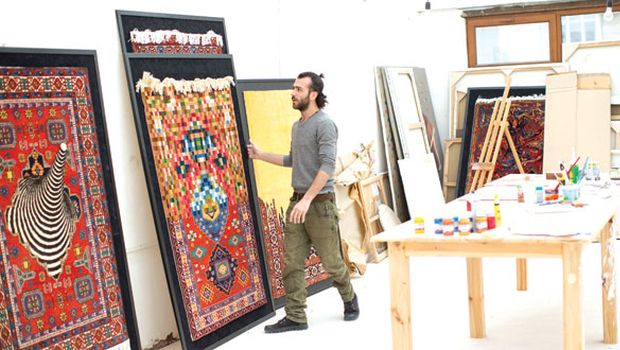Dubai, Asharq Al-Awsat—Azerbaijan is famous for its carpets, and rightly so. With their intricate repeating patterns and geometrical motifs, woven expertly by practitioners whose methods and techniques have not changed for centuries, Azerbaijani carpets are popular the world over. The tradition is held in such high regard that in 2010 UNESCO included the art of Azerbaijani carpet weaving among its ‘Intangible Cultural Heritage of Humanity’ list.
All the more curious, then, to meet an artist from the country whose artistic calling-card is the “destruction” of these stunning rugs. Unweaving parts of traditionally made Azerbaijani carpets, Fayeq Ahmed then weaves in new, quirky and unexpected images or motifs—maybe in the corner of the carpet, or somewhere else equally arresting.
When Asharq Al-Awsat met him in Dubai, Ahmed was busy at work “destroying” a number of carpets, ready to bring them back to life again in time for a show in September at the Cuadro Fine Art Gallery in Dubai, situated in the city’s stunning Dubai International Finance Center building.
Ahmed is particularly fond of the work currently displayed at the Cuadro Gallery, which was part of his last show there during the Art Dubai festival. Instead of weaving patterns into the carpet, as he did in previous works, Ahmed decided to totally dismantle the piece, unweaving the threads entirely, then re-weaving them—keeping some of the old patterns intact—onto a white canvas-like background so that they looked like lines of paint on a painting. The final icing on what is a very unorthodox cake are the lines of thread that extend outwards from the painting, stretching out like sentient tentacles from the window of the gallery, striving to reach the adjacent building and giving the work an air of tension and conflict—two dimensions versus three, canvas versus carpet (versus sculpture, perhaps), tradition versus innovation.

One of Fayeq Ahmed’s works displayed at the Cuadro Gallery in Dubai. (Picture courtesy of the Cuadro Gallery)
In fact tensions between the old and the new, the traditional and the modern, are central to Ahmed’s work. The idea of freeing oneself from—or destroying, as Ahmed puts it—the traditional form carries numerous connotations regarding the contrast between tradition and innovation, the adherence to age-long customs and the youthful desire to rebel. “The old and the new, the past and the present; they are all expressive of the internal struggle. Deep inside me, there are Azerbaijani rules and traditions. Part of me is traditional and conservative, but the other part is rebellious. I’m always somewhere in between the two,” says Ahmed.
“Yes, there are things which we think cannot change such as the design of an old carpet. Sometimes, I like to destroy the traditional form in order to produce a new one,” he adds.
Yet, when an artist “destroys” an old form, he does not dispense with it entirely, says Ahmed, and so we see a meeting—or a clash—between both the old and the new in his work. “I maintain the harmony between them,” he says.
The “traditional part” of Ahmed’s work—the old patterns on the carpet—are systematic and uniform, presenting a logical and harmonious form. “All the old forms are well manufactured,” he says. But Ahmed’s “interventions” are much more haphazard in nature. “When I rework the piece, I’m still in the process of thinking.”
“I think what I am doing is modifying the carpet’s main shape to come up with a different one. I like the contrast and also love to break rules in order to feel free when producing a new work.” Ahmed admits he likes using carpets because of their symbolic value, a storehouse for numerous traditions and rules that took root over centuries through the efforts of generations and generations of Azerbaijanis—which he then likes to mess around with. “People love to have rules and have a clear system to follow,” he says, “but I think it is important to accept the idea of breaking these rules in order to begin thinking of more important issues in life.”
Ahmed spent his early years in Azerbaijan’s capital, Baku, but he left the country at the age of eight. Despite this, he always carried with him the memory of watching people weaving carpets in his home city, a cultural activity which he says is now in danger. “Young girls in Azerbaijan used to compete with one another in weaving and embroidering textiles. Yet, the pieces wavered by the fingers of those young girls are kept only in their family houses, and no strangers are allowed to see their products. Having returned to my hometown recently, I found out that such a wonderful tradition has disappeared, as girls now are preoccupied with holding smart phones.
But not everyone appreciates what Ahmed is doing. He recalls a story about the genesis of another one of his works currently in the Cuadro. “I went to a famous carpet weaver to buy an old carpet, and showed him the drawing I wanted to do on it. The man refused adamantly, thinking that I was mocking him . . . In the past, I always received aggressive reactions because people failed to understand what I wanted to do with the carpets, which they see as part of Azerbaijan’s heritage. There are a number of craftsmen from one family who work with me now on some pieces. It took me one full year to convince them of the idea of my work, but now they seem to have understood it.”
This is unsurprising, perhaps. The carpet is often considered a symbol of continuity in the Eastern world. Carpet weaving itself is usually a family endeavor, and families keep carpets in their homes, passing them on from generation to generation, as they do the skills and traditions of weaving the textiles themselves. If an air of discontinuity is what Ahmed is looking to invoke through his works, then he has very much picked the right raw materials with which to produce them.

